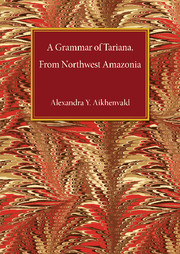Book contents
- Frontmatter
- Dedication
- Contents
- List of tables, schemes and diagrams
- Preface
- Acknowledgements
- Organisation and cross-referencing
- List of abbreviations
- Map
- 1 The language and its speakers
- 2 Phonology
- 3 Word classes
- 4 Nominal morphology and noun structure
- 5 Noun classes and classifiers
- 6 Possession
- 7 Case marking and grammatical relations
- 8 Number
- 9 Further nominal categories
- 10 Derivation and compounding
- 11 Closed word classes
- 12 Verb classes and predicate structure
- 13 Valency changing and argument rearranging mechanisms
- 14 Tense and evidentiality
- 15 Aspect, Aktionsart and degree
- 16 Mood and modality
- 17 Negation
- 18 Serial verb constructions and verb compounding
- 19 Complex predicates
- 20 Participles and nominalisations
- 21 Clause types and other syntactic issues
- 22 Subordinate clauses and clause linking
- 23 Relative clauses
- 24 Complement clauses
- 25 Discourse organisation
- 26 Issues in etymology and semantics
- Appendix. The main features of the Tariana dialects
- Texts
- Vocabulary
- References
- Index of authors, languages and subjects
5 - Noun classes and classifiers
Published online by Cambridge University Press: 05 August 2013
- Frontmatter
- Dedication
- Contents
- List of tables, schemes and diagrams
- Preface
- Acknowledgements
- Organisation and cross-referencing
- List of abbreviations
- Map
- 1 The language and its speakers
- 2 Phonology
- 3 Word classes
- 4 Nominal morphology and noun structure
- 5 Noun classes and classifiers
- 6 Possession
- 7 Case marking and grammatical relations
- 8 Number
- 9 Further nominal categories
- 10 Derivation and compounding
- 11 Closed word classes
- 12 Verb classes and predicate structure
- 13 Valency changing and argument rearranging mechanisms
- 14 Tense and evidentiality
- 15 Aspect, Aktionsart and degree
- 16 Mood and modality
- 17 Negation
- 18 Serial verb constructions and verb compounding
- 19 Complex predicates
- 20 Participles and nominalisations
- 21 Clause types and other syntactic issues
- 22 Subordinate clauses and clause linking
- 23 Relative clauses
- 24 Complement clauses
- 25 Discourse organisation
- 26 Issues in etymology and semantics
- Appendix. The main features of the Tariana dialects
- Texts
- Vocabulary
- References
- Index of authors, languages and subjects
Summary
Tariana has a complicated system of several different types of classifiers, and two genders. Gender (feminine and non-feminine) agreement is realised in verb-argument constructions and on some possessors (see Chapters 6 and 12); it is also marked on some nouns with human referents (see §10.1). There are no gender distinctions in the plural.
Classifier suffixes are used in the following morphosyntactic contexts:
(a) as noun class agreement markers on adjectives and some other modifiers;
(b) as numeral classifiers, with numbers;
(c) as derivational affixes on nouns;
(d) as possessed classifiers in possessive NPs, where they attach to the possessive marker and characterise the possessed noun;
(e) as verbal classifiers, to characterise the nature of an S/O argument on the verb;
(f) with demonstratives, articles and other modifiers from closed classes (see Chapter 11).
There is a generic classifier used only in possessive constructions – see §6.5.2. The classifier suffixes used in all these functions are almost, but not quite, the same. All the classifiers have anaphoric and referent-tracking functions in discourse. Noun class markers can be used more than once in a noun phrase marking agreement with different heads at different levels of embedding. Other classifiers cannot be ‘stacked’ in this way.
Most classifiers function as derivational affixes. Under specific discourse conditions, any noun with an inanimate referent can be used as a classifier (being ‘repeated’ onto an adjective, a numeral, a verb or a possessive marker).
- Type
- Chapter
- Information
- A Grammar of Tariana, from Northwest Amazonia , pp. 87 - 121Publisher: Cambridge University PressPrint publication year: 2003



